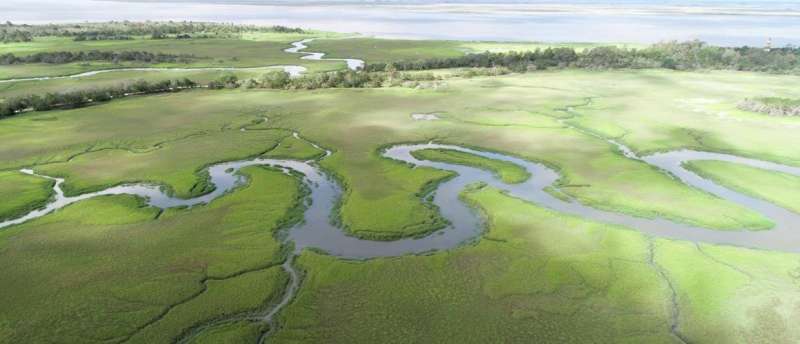This article has been reviewed according to Science X's editorial process and policies. Editors have highlighted the following attributes while ensuring the content's credibility:
fact-checked
peer-reviewed publication
trusted source
proofread
New study focusing on 750,000 acres of US coastal areas finds mussels act as ecosystem engineers

Faunal organisms such as the humble mussel often play an underappreciated yet important role in protecting and building coastal ecosystems, according to a new study led by the Carbon Containment Lab at the Yale School of the Environment.
"As sea levels rise, coastal ecosystems have to adapt and evolve to changing conditions," says Sinéad Crotty, associate director of science at the CC Lab and lead author of the study. "This study shows that small and innocuous animals that live within an ecosystem can play a critical role in helping coastal systems persist in the face of climate change."
Mussels (Geukensia demissa) serve as "ecosystem engineers"—organisms that directly or indirectly drive habitat construction and control the availability of resources to other organisms, according to the study's findings. Mussels are considered indicators of water quality, helping to keep streams and rivers clean by absorbing heavy metals and filtering harmful silt and particulates as they feed and breathe in aquatic ecosystems.
Their shells also provide habitat and nesting sites for insects, small fish, and plants. In addition to these valuable characteristics, mussels also deposit large volumes of material on marsh surfaces through their feeding process. This contribution of sediment helps marshes grow through a process called accretion, which is the natural action of sand, soil or silt washing up to the land from the seashore or river.
The study focused on 750,000 acres of expansive salt marsh systems in the U.S. along the coastal area known as the South Atlantic Bight, a region stretching over 150 miles from Cape Fear, North Carolina to Cape Canaveral, Florida and examined research on a variety of fauna including crabs, lugworms, and ghost shrimp. Field research for the study, which was recently published in Nature Communications, included surveys of mussel cover across the South Atlantic Bight. More detailed field measurements were taken on Sapelo Island, a barrier island off the coast of central Georgia.
In addition to measurements taken across seasons and tidal phases, the researchers deployed three experiments designed to test mussels' impact on accretion from small, local scales to whole landscape scales. The largest experiment involved moving over 200,000 mussels by hand from one landscape to another and measuring changes to the marsh elevation over three years.
"We found that, in reality, the effects of mussels are far greater than predicted by the models, and occur at large, landscape scales," Crotty says.
Similar trends are likely to occur with other fauna engineers, such as bioturbating crabs or worms, the authors note. Including ecosystem engineers in future modeling and ecosystem management will be important as sea levels continue to rise, the study's authors say.
"This study can help us think through how we prioritize certain marsh areas for protection," Crotty says. "Given that mussels are disproportionately important in driving accretion and other ecosystem functions, we should prioritize their protection, or outplanting, as a means to promoting all of their associated benefits."
The study's co-authors include researchers from the Department of Civil and Coastal Engineering at the University of Florida School for Sustainable Infrastructure and Environment, and the Royal Netherlands Institute of Sea Research, and Department of Physical Geography, Utrecht University.
Co-author Tjeerd J. Bouma, senior scientist at the Royal Netherlands Institute for Sea Research, says the study provides important data on salt marches and climate change.
"The present study provides new insight into the mechanisms by which coastal ecosystems that are highly valuable for flood defense, such as salt marshes, can cope with sea-level rise," he says.
More information: Sinéad M. Crotty et al, Faunal engineering stimulates landscape-scale accretion in southeastern US salt marshes, Nature Communications (2023). DOI: 10.1038/s41467-023-36444-w
Journal information: Nature Communications
Provided by Yale University


















